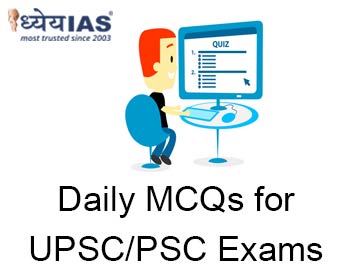Home > Daily-mcqs
Daily-mcqs 25 Mar 2025

Q1:
Which Indian government body is responsible for investigating dumping cases and recommending anti-dumping duties?
A: Competition Commission of India (CCI)
B: Directorate General of Trade Remedies (DGTR)
C: Central Board of Indirect Taxes and Customs (CBIC)
D: Ministry of External Affairs (MEA)
Answer: B
Explanation:
DGTR, under the Ministry of Commerce, investigates dumping cases and trade remedies, including anti-dumping duties, countervailing duties, and safeguard measures
It was established on May 17, 2018, to protect Indian industries from unfair trade practices like dumping, subsidies, and import surges. It investigates anti-dumping and countervailing duties (CVD), handles trade litigation, engages with the WTO, and conducts awareness programs. By ensuring fair competition, DGTR helps maintain a balanced trade environment while upholding WTO regulations.
Q2:
Consider the following statements regarding India’s GDP growth: 1. India’s GDP has grown from $2.1 trillion in 2015 to $4.3 trillion in 2025, marking a 105% increase. 2. As of 2025, India has overtaken Germany and Japan to become the third-largest economy in the world. 3. India’s economic growth in the last decade is higher than that of China, the U.S., and Russia in percentage terms. How many of the above statements are correct?
A: Only 1
B: Only 2
C: All three
D: None
Answer: B
Explanation:
Q3:
Match the following glaciers with their locations: Glacier Location A. Yala Glacier 1. Venezuela B. Peyto Glacier 2. Iceland C. Humboldt Glacier 3. Canada D. Okjökull Glacier 4. Nepal Which of the above pairs are correctly matched?
A: A-1, B-2, C-3, D-4
B: A-4, B-3, C-1, D-2
C: A-3, B-4, C-2, D-1
D: A-2, B-1, C-4, D-3
Answer: B
Explanation:
Q4:
Consider the following statements regarding MSMEs in India: 1. MSMEs contribute nearly 30% to India's GDP and play a crucial role in economic growth. 2. The MSME sector accounts for 60% of India’s total exports. 3. The revised classification criteria for MSMEs are based on investment in plant & machinery and annual turnover. How many of the above statements are correct?
A: Only 1
B: Only 2
C: All three
D: None
Answer: B
Explanation:
Q5:
What is the BPaLM regimen, recently introduced for drug-resistant TB treatment?
A: A traditional herbal treatment used for TB patients in tribal areas.
B: A shorter, all-oral TB treatment using a combination of four drugs.
C: A new vaccine for TB prevention in high-risk populations.
D: A nutritional support program for TB patients under Ni-kshay Poshan Yojana.
Answer: B
Explanation:
BPaLM regimen is a shorter, all-oral treatment for drug-resistant tuberculosis (DR-TB), replacing longer and more toxic injectable treatments.
It consists of four key drugs:
Benefits of BPaLM: